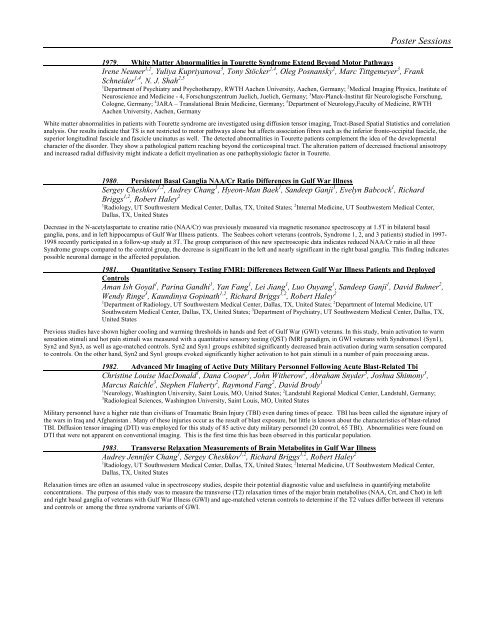TRADITIONAL POSTER - ismrm
TRADITIONAL POSTER - ismrm
TRADITIONAL POSTER - ismrm
Create successful ePaper yourself
Turn your PDF publications into a flip-book with our unique Google optimized e-Paper software.
Poster Sessions<br />
1979. White Matter Abnormalities in Tourette Syndrome Extend Beyond Motor Pathways<br />
Irene Neuner 1,2 , Yuliya Kupriyanova 3 , Tony Stöcker 2,4 , Oleg Posnansky 2 , Marc Tittgemeyer 3 , Frank<br />
Schneider 1,4 , N. J. Shah 2,5<br />
1 Department of Psychiatry and Psychotherapy, RWTH Aachen University, Aachen, Germany; 2 Medical Imaging Physics, Institute of<br />
Neuroscience and Medicine - 4, Forschungszentrum Juelich, Juelich, Germany; 3 Max-Planck-Institut für Neurologische Forschung,<br />
Cologne, Germany; 4 JARA – Translational Brain Medicine, Germany; 5 Department of Neurology,Faculty of Medicine, RWTH<br />
Aachen University, Aachen, Germany<br />
White matter abnormalities in patients with Tourette syndrome are investigated using diffusion tensor imaging, Tract-Based Spatial Statistics and correlation<br />
analysis. Our results indicate that TS is not restricted to motor pathways alone but affects association fibres such as the inferior fronto-occipital fascicle, the<br />
superior longitudinal fascicle and fascicle uncinatus as well. The detected abnormalities in Tourette patients complement the idea of the developmental<br />
character of the disorder. They show a pathological pattern reaching beyond the corticospinal tract. The alteration pattern of decreased fractional anisotropy<br />
and increased radial diffusivity might indicate a deficit myelination as one pathophysiologic factor in Tourette.<br />
1980. Persistent Basal Ganglia NAA/Cr Ratio Differences in Gulf War Illness<br />
Sergey Cheshkov 1,2 , Audrey Chang 1 , Hyeon-Man Baek 1 , Sandeep Ganji 1 , Evelyn Babcock 1 , Richard<br />
Briggs 1,2 , Robert Haley 2<br />
1 Radiology, UT Southwestern Medical Center, Dallas, TX, United States; 2 Internal Medicine, UT Southwestern Medical Center,<br />
Dallas, TX, United States<br />
Decrease in the N-acetylaspartate to creatine ratio (NAA/Cr) was previously measured via magnetic resonance spectroscopy at 1.5T in bilateral basal<br />
ganglia, pons, and in left hippocampus of Gulf War Illness patients. The Seabees cohort veterans (controls, Syndrome 1, 2, and 3 patients) studied in 1997-<br />
1998 recently participated in a follow-up study at 3T. The group comparison of this new spectroscopic data indicates reduced NAA/Cr ratio in all three<br />
Syndrome groups compared to the control group, the decrease is significant in the left and nearly significant in the right basal ganglia. This finding indicates<br />
possible neuronal damage in the affected population.<br />
1981. Quantitative Sensory Testing FMRI: Differences Between Gulf War Illness Patients and Deployed<br />
Controls<br />
Aman Ish Goyal 1 , Parina Gandhi 1 , Yan Fang 1 , Lei Jiang 1 , Luo Ouyang 1 , Sandeep Ganji 1 , David Buhner 2 ,<br />
Wendy Ringe 3 , Kaundinya Gopinath 1,2 , Richard Briggs 1,2 , Robert Haley 2<br />
1 Department of Radiology, UT Southwestern Medical Center, Dallas, TX, United States; 2 Department of Internal Medicine, UT<br />
Southwestern Medical Center, Dallas, TX, United States; 3 Department of Psychiatry, UT Southwestern Medical Center, Dallas, TX,<br />
United States<br />
Previous studies have shown higher cooling and warming thresholds in hands and feet of Gulf War (GWI) veterans. In this study, brain activation to warm<br />
sensation stimuli and hot pain stimuli was measured with a quantitative sensory testing (QST) fMRI paradigm, in GWI veterans with Syndromes1 (Syn1),<br />
Syn2 and Syn3, as well as age-matched controls. Syn2 and Syn1 groups exhibited significantly decreased brain activation during warm sensation compared<br />
to controls. On the other hand, Syn2 and Syn1 groups evoked significantly higher activation to hot pain stimuli in a number of pain processing areas.<br />
1982. Advanced Mr Imaging of Active Duty Military Personnel Following Acute Blast-Related Tbi<br />
Christine Louise MacDonald 1 , Dana Cooper 1 , John Witherow 2 , Abraham Snyder 3 , Joshua Shimony 3 ,<br />
Marcus Raichle 3 , Stephen Flaherty 2 , Raymond Fang 2 , David Brody 1<br />
1 Neurology, Washington University, Saint Louis, MO, United States; 2 Landstuhl Regional Medical Center, Landstuhl, Germany;<br />
3 Radiological Sciences, Washington University, Saint Louis, MO, United States<br />
Military personnel have a higher rate than civilians of Traumatic Brain Injury (TBI) even during times of peace. TBI has been called the signature injury of<br />
the wars in Iraq and Afghanistan . Many of these injuries occur as the result of blast exposure, but little is known about the characteristics of blast-related<br />
TBI. Diffusion tensor imaging (DTI) was employed for this study of 85 active duty military personnel (20 control, 65 TBI). Abnormalities were found on<br />
DTI that were not apparent on conventional imaging. This is the first time this has been observed in this particular population.<br />
1983. Transverse Relaxation Measurements of Brain Metabolites in Gulf War Illness<br />
Audrey Jennifer Chang 1 , Sergey Cheshkov 1,2 , Richard Briggs 1,2 , Robert Haley 2<br />
1 Radiology, UT Southwestern Medical Center, Dallas, TX, United States; 2 Internal Medicine, UT Southwestern Medical Center,<br />
Dallas, TX, United States<br />
Relaxation times are often an assumed value in spectroscopy studies, despite their potential diagnostic value and usefulness in quantifying metabolite<br />
concentrations. The purpose of this study was to measure the transverse (T2) relaxation times of the major brain metabolites (NAA, Crt, and Chot) in left<br />
and right basal ganglia of veterans with Gulf War Illness (GWI) and age-matched veteran controls to determine if the T2 values differ between ill veterans<br />
and controls or among the three syndrome variants of GWI.















